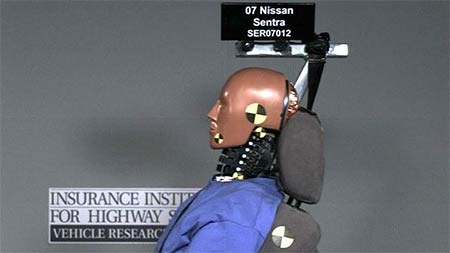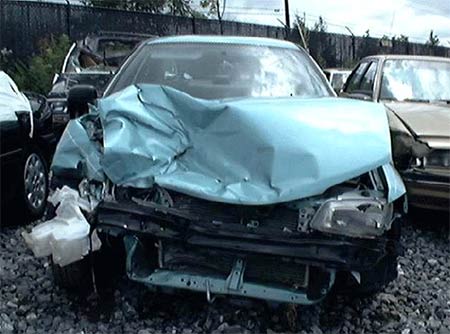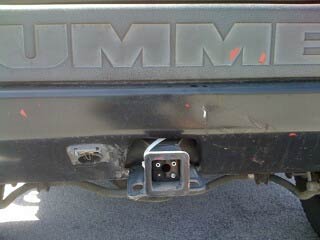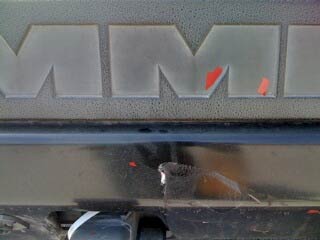By Matthew J. DeGaetano, DC and Adam Shafran, DC
Rear Crash Protection in Cars:
Seat/Head Restraints in Two of Every Three Models are Marginal or Poor

Seat/head restraint designs in 22 current car models are rated good for rear crash protection, but those in 53 other cars are rated marginal or poor. The latest evaluations of occupant protection in rear-end collisions by the Insurance Institute for Highway Safety found that the seat/head restraints in more than 60 percent of car models fall short of current state-of-the-art protection from neck injury or whiplash.
The ratings of good, acceptable, marginal, or poor are based on geometric measurements of head restraints and simulated crashes that together assess how well people of different sizes would be protected in a typical rear-end collision.
Risk of injury to the cervical spine is high in rear impact crashes. Here is a case example to consider:

Figure A, 2001 Mirage; Case # 102000721 traveling at 18 mph
The delta V (change of velocity the vehicle underwent, as calculated by Winsmash) was determined to have been 17-21 mph was the estimated speed hitting the Hummer in this example.
The crash between the 2001 Mitsubishi and the 2004 Hummer is considered to be very elastic. Due to the utility design of the Hummer it does not absorb energy, creating more momentum moving it forward at a faster rate of acceleration. Figures B, C, D, the damage Hummer is irrelevant due to the force delivered by the Mirage.
[one-third-first] Figure F [/one-third-first][one-third]
Figure F [/one-third-first][one-third] Figure G [/one-third][one-third]
Figure G [/one-third][one-third] Figure H [/one-third]
Figure H [/one-third]
The change of velocity (delta V) experienced by the Hummer (Figures F, G, and H) was not the same as its occupant. It appears that the Hummer has very little damage but the occupant can experience high acceleration. The fact the Hummer has a trailer hitch induces a 22% increase in the acceleration pulse.
Generally, at higher delta V collisions, g forces are higher despite the increasing plasticity of the collision and increased deflection of seat backs. Also, peak accelerations are more abrupt with increasing velocity. However, these relationships are surprisingly flat. In a study of 445 frontal crashes with injury and 302 side impact crashes with injury, Jakobsson et al. (1326) plotted injury risk against Equivalent barrier speed (EBS).
Studies to consider
Ono, et al 1997 (1150): More injurious compression in the facet joints during extension, even before the head hits/strikes the seat’s head restraint. Impact velocities were 2.5, 3.7 and 5 mph. Also, C5-6 compressive loading and bending moment was found along with sudden extension causing compression in the facet joint, rather than gliding.
Siegmund, et al 1997 (1175): Peak head accelerations in the 5 mph impact speed tests ranged from 6.7 g to 12.0g. Lower back kinematics–the first part of the body to be accelerated by the seat back is the low back and pelvis.
Brault, et al 1998 (1146): Recent crash testing produced injuries in 29% and 38% in 2.5 mph and 5 mph Delta Vs low speed rear impact collisions.
CRASH 1999: Rear end collision impact crashes of 5.4, 9.3 and 9.9 mph generated Delta Vs of 3.1, 5.2 and 7 mph, respectively- well above the known injury threshold.
Among the winners are seat designs in all Volvos; Audi A4, S4 and A6; Ford Five Hundred/ Mercury Montego; Nissan Sentra and Versa; Saab 9-3; and Subaru Impreza and Legacy/Outback. Seat/head restraints in 12 other car models are rated acceptable. These results show some improvement since the Institute began rear impact tests of seat/head restraints in 2004. Seats in only 8 car models earned good ratings in 2004. These vehicles have proven to maintain much safer head restraint systems.
“Even though we have more good performers, it’s disappointing that so many designs are still rated marginal or poor,” says Institute president Adrian Lund. “Neck injuries are common in crashes, and it’s not difficult or expensive to design more protective seat/head restraints.”
Rear-end collisions are frequent, and neck injuries are the most common injuries reported in automobile crashes. They account for 2 million insurance claims each year, costing at least $8.5 billion. Such injuries aren’t life threatening, but they can be painful and debilitating.
“We’re simulating what happens when a vehicle rear-ends another one in commuter traffic or at a stop light,” Lund says. “People think of head restraints as head rests, but they’re not. They’re important safety features. You’re more likely to need the protection of a good head restraint than the other safety devices in your vehicle because rear-end crashes are so common.”
Good seat/head restraint design keeps head and torso moving together
When a vehicle is struck in the rear and driven forward, the vehicle seats accelerate occupants’ torsos forward. Unsupported, an occupant’s head will lag behind the forward movement of the torso. This differential motion causes the neck to bend and stretch. The higher the torso acceleration, the more sudden the motion, the higher the forces on the neck, and the more likely a neck injury is to occur.
“The key to reducing whiplash injury risk is to keep the head and torso moving together,” Lund explains. “To accomplish this, the geometry of a head restraint has to be adequate, and so do the stiffness characteristics of the vehicle seat. Then the seat and head restraint have to work in concert to support an occupant’s neck and head, accelerating them with the torso as the vehicle is driven forward.”
A head restraint should extend at least as high as the center of gravity of the head of the tallest expected occupant. A restraint also should be positioned close to the back of an occupant’s head so it can contact the head and support it early in a rear-end crash. If a restraint isn’t positioned behind the head, it cannot support the head, but good restraint geometry by itself isn’t sufficient. A seat also has to be designed so its head restraint doesn’t move backward in a rear impact because this would prevent the restraint from catching the head. At the same time, a vehicle seat cannot be too stiff. It has to “give” so an occupant will sink into it, moving the head closer to the restraint.
Geometry is improving
The Institute doesn’t test seats with head restraints that are rated marginal or poor for geometry. These seats automatically earn the lowest rating of poor because their head restraints cannot be positioned to protect many taller people. In this round of evaluations, the worst ratings based on geometry belong to seats in the Cadillac DTS, Pontiac Grand Prix, Suzuki Forenza and Reno, plus some seats in the BMW 5 series, Buick Lacrosse, and Mitsubishi Galant.
“Still it’s encouraging that the seat/head restraint combinations in only 7 of the models we evaluated didn’t make it to the dynamic test because of marginal geometry,” Lund says. “When we began evaluating the geometry of head restraints in 1995, most earned the lowest rating of poor. Back then, head restraints in most cars weren’t tall enough or close enough to the head to begin to provide adequate protection for people as tall as an average-size man.”
In response to the Institute’s 1995 evaluations, manufacturers began to make changes. They designed head restraints taller and closer so they’re more likely to be in position to catch people’s heads in rear-end collisions. Further improvements are being driven by the federal government. A new regulation will require head restraints to extend higher and fit closer to the backs of people’s heads by the 2009 model year. Automakers also have been spurred to better designs by the Institute’s TOP SAFETY PICK award. Winning vehicles have to earn good ratings in all three Institute crash tests — front, side, and rear.
“Audi and Subaru redesigned their seats and head restraints specifically to earn TOP SAFETY PICK in 2007,” Lund points out. “Other automakers are working on this aspect of crashworthiness specifically to earn the award.”
International effort by insurers
Recognizing improvements in head restraint geometry and the need to move beyond ratings based solely on geometry, Institute researchers joined with other whiplash injury prevention experts in late 2000 to organize the International Insurance Whiplash Prevention Group (IIWPG). IIWPG conducted extensive research and testing to develop the procedures for the dynamic tests and evaluation criteria used by member research groups, including the Institute, to rate the performance of seat/head restraint combinations in vehicles sold in a number of world markets. Ratings also are being released by IIWPG members in Canada, the United Kingdom, Europe, and Australia.
Sled test simulates rear-end collision
Seat/head restraint ratings are based on a two-step evaluation. In the first step restraint geometry is rated using measurements of height and distance from the back of the head of a mannequin that represents an average-size man. Seats with good or acceptable geometric ratings are subjected to a dynamic test conducted on a crash simulation sled. The sled test replicates the forces in a stationary vehicle that’s rear-ended by another vehicle of the same weight going 20 mph, which accelerates the struck vehicle to 10 mph. The sled is a movable steel platform that runs on fixed rails and can be programmed to re-create the accelerations that occur inside vehicles during real-world crashes.
A dummy specially designed to assess rear-end crash protection, BioRID, is used to measure the forces on the neck during the simulated crashes. Researchers also measure how hard the seatback pushes on the dummy’s back and how quickly the head restraint supports the head.
The Institute’s dynamic ratings of good, acceptable, marginal, or poor are derived from two seat design parameters (peak acceleration of the dummy’s torso and time from impact initiation to head restraint contact with the dummy’s head) plus neck tension and shear forces recorded on BioRID during the test. The sooner a restraint contacts the dummy’s head and the lower the acceleration of the torso and the forces on BioRID’s neck, the better the dynamic rating. A seat/head restraint’s dynamic evaluation is combined with its geometric evaluation to produce an overall rating.
BIBLIOGRAPHY
1.M.D. Gilchrist, D. O’Donoghue & T. J. Horgan ; A two-dimensional analysis of the biomechanics of frontal and occipital head impact injuries; pages 253-262
2.Kumar, Shrawan ; Narayan, Yogesh ; Amell, Tyler
Analysis of low velocity frontal impacts ; Clinical Biomechanics, 2003, Vol.18(8), pp.694-703 [Peer Reviewed Journal]
3, Kumar, Shrawan ; Ferrari, Robert ; Narayan, Yogesh ; An Observational Electromyography Study of the Effect of Trunk Flexion in Low-Velocity Frontal Whiplash-Type Impacts ; Archives of Physical Medicine and Rehabilitation, 2006, Vol.87(4), pp.496-503 [Peer Reviewed Journal]
4 Živkovic, Vladimir ; Nikolic, Slobodan ; Babic, Dragan ; Jukovic, Fehim;The significance of pontomedullar laceration in car occupants following frontal collisions: A retrospective autopsy study;Forensic Science International, 2010, Vol.202(1), pp.13-16 [Peer Reviewed Journal]
5. Panjabi MM, Pearson AM, Ito S, Ivancic PC, Gimenez E, Tominaga Y. Cervical spine ligament injury during simulated frontal impact. Spine 2004;29(21):2395-2403.
6. Lindquist MO, Hall AR, Björnstig UL. Kinematics of belted fatalities in frontal collisions: A new approach in deep studies of injury mechanisms. Department of Surgical and Perioperative Sciences, Division of Surgery, Umeå University, Saab Automobile, Enginuity Services International, Trollhättan, Sweden.
7. Staff T, Eken T, Hansen TB, Steen PA, Søvik S, a field evaluation of real life motor vehicle accidents: presence of unrestrained objects and their association with distribution and severity of patient injuries. Norwegian Air Ambulance Foundation, Department of Research, Holterveien 24, PO Box 94, 1441 Drøbak, Norway.
8.Rupp JD, Schneider LW. Injuries to the hip joint in frontal motorvehicle
crashes: biomechanical and real-world perspectives. Orthop Clin North Am. 2004; 35:493-504, vii.
9. Mackay M. Engineering in accidents: vehicle design and injuries. Injury 1994; 25:615-21.
10.. Mayrose J, Jehle D, Hayes M, et al. Infl uence of the unbelted rear-seat
passenger on driver mortality: “the backseat bullet”. Acad Emerg Med2005; 12:130-4.
11. Campbell DJ, Sprouse LR 2nd, Smith LA, Kelley JE, Carr MG.
Injuries in pediatric patients with seatbelt contusions. Am Surg 2003;
69:1095-9.
12. Munshi IA, Patton W. A unique pattern of injury secondary to seatbelt related blunt abdominal trauma. J Emerg Med 2004; 27:183-5.
13. Eid H O, Abu-Zidan F M, Biomechanics of road traffic collision
injuries: a clinician’s perspective; Trauma Group, Faculty of Medicine and Health Sciences, United Arab Emirates University,
(1146) Brault JR, Wheeler JB, Siegmund GP, Brault EJ: Clinical response of human subjects to rear-end automobile collisions. Archives of Physical Medicine & Rehabilitation 79:72-80, 1998.
(1150) Ono K, Kaneoka K, Wittek A, Kajzer J: Cervical injury mechanism based on the analysis of human cervical vertebral motion and head-neck-torso kinematics during low speed rear impacts. 41st Stapp Car Crash Conference Proceedings. SAE paper 973340, 339-356, 1997.
(1175) Siegmund GP, King DJ, Lawrence JM, Wheeler JB, Brault JR, Smith TA: Head/neck kinematic response of human subjects in low-speed rear-end collisions. SAE Technical Paper 973341, 357-385, 1997.
(1326) Jakobsson L, Norin H, Isaksson-Hellman I: Parameters influencing the risk of AIS 1 neck injuries in frontal and side impacts. International Research Council on the Biomechanics of Impact (IRCOBI) Conference Proceedings, Montpellier, France, Sept 20-22, 2000.

